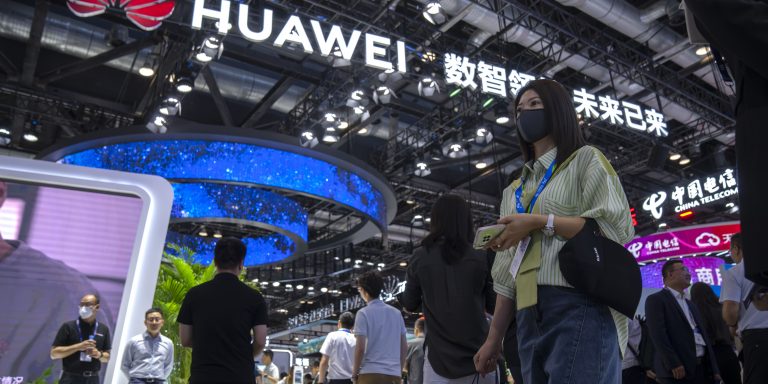INTELBRIEF
September 22, 2023
IntelBrief: Is China Chipping Away at U.S. Trade Restrictions?

Bottom Line Up Front
- The release of a new Chinese smartphone may represent Beijing’s shifting tactics to skirt U.S. trade and export restrictions surrounding microchips used for valuable tech products.
- The microchip powering the new phone is said to be China’s most advanced homegrown microchip yet.
- The development comes as the United States has sought to cut off China’s access to Western and allied semiconductor technologies, calling into question the effectiveness of these efforts.
- Beijing has called U.S. export control measures an “abuse” of export controls and a violation of free trade principles, accusing the United States of harboring a “Cold War mentality” as it seeks to contain China’s economic and geopolitical ascendancy.
Hailed by Chinese nationalists and state-backed media as an indication of “Made-in-China” technological prowess, experts suggest Huawei’s latest smartphone release is more likely a result of creative efforts to skirt U.S. trade and export restrictions. The Chinese telecom company Huawei, which has been the subject of U.S. sanctions and trade restrictions for years, released a new smartphone in early September that reportedly includes China’s most advanced homegrown microchip to date. The release of the Mate 60 Pro smartphone arrived while U.S. Secretary of Commerce Gina Raimondo was visiting Beijing in what was likely intended to be a jab at the United States over its restrictions. The new Kirin 9000s microchip, produced by the partially state-owned Semiconductor Manufacturing International Corporation (SMIC), raises questions about the People’s Republic of China’s (PRC) ability to re-invent its semiconductor industry amid U.S. export restrictions and without U.S. technology. Still, the latest developments do not suggest that China’s domestic tech sector has yet reached the capacity of U.S. semiconductor companies.
Semiconductors have become a focal point in the technological competition between the U.S. and the PRC, which is just one part of the broader competition between the two geopolitical heavyweights. Since 2018, the United States has implemented sanctions, trade, and export restrictions related to advanced semiconductor chips to limit PRC dual-use technological advancements, such as artificial intelligence and quantum computing. For example, in 2019, the Trump administration placed Huawei on the Entity List, imposing an export license requirement on all exports, re-exports, and transfers of items subject to the U.S. Export Administration Regulations to Huawei (or 68 additional listed affiliates). The move was undertaken because the U.S. government believes that Huawei has been involved in activities contrary to the national security or foreign policy interests of the United States. A year later, the United States blocked shipments of advanced semiconductors from global chipmakers, which significantly impacted the company’s ability to compete with other 5G smartphone producers. Last October, the Biden administration unveiled sweeping export controls on U.S.-origin advanced semiconductors and technology to China and has since worked to convince the Netherlands and Japan to join its efforts. The U.S. strategy aims to hamper the Chinese military technological advancements while also slowing down the PRC’s efforts to acquire the technology and know-how to ramp up domestic production of cutting-edge chips.
Beijing has called the measures an “abuse” of export controls and a violation of free trade principles, accusing the United States of harboring a “Cold War mentality” as it seeks to contain China’s economic and geopolitical ascendancy. Experts and analysts have assessed that it may take China five-to-ten years to ramp up domestic production of semiconductors that can compete, which would significantly impact research and development (R&D). This has reportedly spurred fierce domestic competition among private sector entities, state-owned enterprises, research centers, and local governments in China to stockpile chips and technology and to get in on orders through special licenses that would allow U.S. companies to continue to sell semiconductors or manufacturing equipment to them. Some reports suggest that private firms are out-bidding state-owned enterprises (SOEs) and local governments as prices are soaring.
Skeptics have argued that the U.S. export controls not only hurt the profits of American and Western companies but will also be counterproductive, forcing the PRC to develop domestic advanced semiconductor production capacity more rapidly. PRC leader Xi Jinping has long stressed the need for China to be self-reliant when it comes to semiconductor manufacturing. In March 2023, during the National People's Congress, Xi declared that “China should work to achieve greater self-reliance and strength in science and technology, promote industrial transformation.” The Chinese Communist Party has rolled out a number of policy measures, including fiscal incentive packages, to promote the country’s domestic semiconductor industry. Huawei’s newest smartphone and SMIC’s seeming advancement have been touted as evidence of China’s rapid advancement in home-grown cutting-edge chip manufacturing. Experts, however, expressed doubts about the scalability of the production and pointed to the possibility that this was achieved through the use of U.S. technology. This would suggest that U.S. trade restrictions and sanctions have been skirted, calling into question Washington’s effectiveness in limiting the ability of Chinese companies to acquire U.S.-origin technology.
As U.S.-PRC strategic competition ramps up, technological advancement is poised to become a key factor. Smaller, technologically advanced states like Japan, the Netherlands, and South Korea will likely continue to find themselves caught in the middle of the U.S.-China technology contest — forced to balance their economic and national security concerns. The United States must be careful not to suffocate those aspects that allow for scientific discovery and innovation to flourish — diversity, freedom to debate, talent attraction, and development — in order to compete responsibly and effectively.